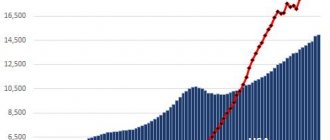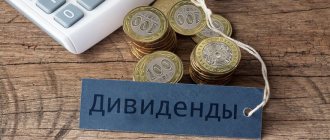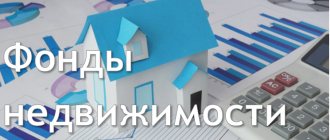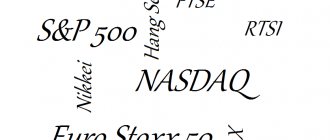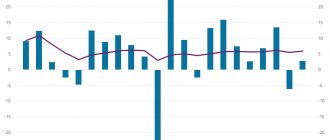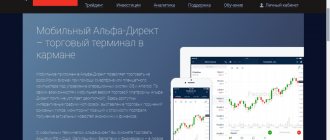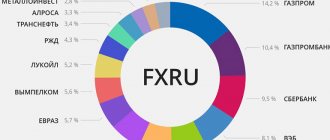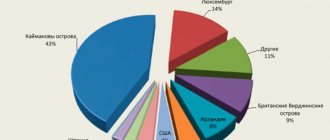Russian investment funds, which were discussed in the previous article, have certain disadvantages, such as very limited selection, high commissions, low transparency, etc.
Much more opportunities for investment and portfolio diversification are provided by foreign mutual (mutual) and exchange-traded (ETF) funds. These are time-tested tools that are very popular. Trillions of dollars are invested in them, and the number of funds amounts to tens of thousands.
Today, it is not difficult for a Russian investor to invest his savings in them. But to do this, you first need to study their features and differences so as not to make mistakes. How to competently approach the choice of foreign funds and what to pay attention to is described in detail in this article.
What is a mutual fund
What is a mutual fund? At its core, it is a diversified portfolio of stocks managed by professional traders. This fund issues its shares, the value of which directly depends on the value of the portfolio. Thus, mutual fund investors make money if the hodgepodge of stocks collected in the fund's portfolio rises in value, and suffer losses when the portfolio's price falls (for example, during periods of a bear market).
In Russia, an analogue of mutual funds are mutual investment funds (UIFs); instead of shares, they sell shares to their investors. Next, we are talking about investing specifically in Western (American and European) mutual funds, the reliability of which has been confirmed for many decades. However, for our Russian mutual funds (for those of them that have already managed to prove their reliability and professionalism of managers), this information will also be relevant.
Who can join
Any citizen can join a mutual investment fund. In Western countries, such an organization is similar to a pension fund. People invest money in these companies for a long time (20-30 years), and when they retire, they use this accumulated capital for personal purposes.
To become an investor, it is enough to sign an agreement with an investment fund and make an initial contribution. The process of transferring funds as monthly installments can be automated. The money will be transferred from the salary to the investor's account in the fund. To do this, you need to write an application and submit it to the human resources department or the management of the company in which you work.
Depending on the terms of the agreement, the return on each dollar invested can range from 10 to 40%, which is a very high figure, considering how low deposit rates exist not only in Western countries, but also in Russia.
How does investing in mutual funds compare favorably with investing in stocks?
When buying shares of a company, an investor should always remember that the price may fall and never rise again. An individual company, no matter how huge a corporation it is today, at one “wonderful” moment can simply go bankrupt, leaving its shareholders high and dry. A serious mutual fund does not face such a fate thanks to:
- Wide diversification of the stock portfolio. When, even with a decline in the entire sector, the value of the portfolio will not drop much thanks to shares of enterprises from other sectors of the economy.
- Professional management. Serious funds are managed by serious people. They do this professionally, and they know when and what assets should be purchased, and which ones need to be urgently disposed of.
Therefore, investing in mutual funds is always beneficial in the long run. If we take American funds as an example, their entire history shows that they always end up showing a profit. It is important to remember here that mutual fund shares are classified as long-term investments, and they bear fruit over an investment period of 10 to 15 years.
Principle of operation
All mutual funds work on almost the same principle. They are formed by an investment company, which sells their shares to investors, and then invests the proceeds in portfolios of securities. By pooling depositors' funds into a portfolio, the head of the company can diversify investments by purchasing bonds and shares in the fund.
The types of instruments chosen determine the purpose of the investment. For example, if an equity investment firm's goal is to generate capital gains, then the lion's share of funds is allocated to growth stocks. If the purpose of a bond fund is to pay coupon income, which is not taxed, then the funds are invested in municipal bonds. At the same time, a bond investment company is formed by issuing bonds in order to diversify the portfolio and reduce the risk of default on individual bonds.
Investors are paid dividends, which are formed from income on securities that make up the bulk of the portfolio. A client who invested $1,000 will receive the same percentage return as someone who invested $100,000. The difference will be that the income of the second investor will be 100 times greater than that of the first (according to the proportionality of their shares in the fund).
When changes in the value of securities in a portfolio occur, the net asset value of the financial intermediary changes accordingly. Price fluctuations are affected by risks inherent in many types of securities: political, economic, market.
How to invest correctly
Proper investment in mutual funds is an excellent way to invest capital. Many people do not understand the simple truth that in order to make a really big fortune, investments in GF must be maintained for at least several economic cycles, during which the ups and downs of the market occur. Many simply do not have the patience and close their positions at those stages of cycles when the price of VF shares begins to decline. Meanwhile, in this case, a decline in prices is an excellent opportunity to buy more shares. Yes, just buy more, or as they say, average on a decline. This is something I strongly advise against doing when investing in stocks, but I do advise doing when investing in mutual funds. After all, as mentioned above, a diversified portfolio of a fund under professional management has a much greater chance of continuing to grow after the next fall.
Varieties
Mutual funds differ in their choice of assets. They can operate:
- Shares. Typically, securities of large companies are selected. Long-term investing is used here because only in the long term can good profits be made.
- Bonds. Investments can be made in debt securities issued by the government or corporations. The first option is more reliable, but less profitable. Sometimes a portfolio is formed from securities belonging to different issuers, including municipal structures.
- Real estate. Here, capital gains are carried out mainly not through purchase and sale, but through the rental of objects. To make such investments on your own, you need a lot of money, and mutual funds allow you to make small investments, but still make a profit.
Mutual funds can also be:
- Balanced. Investments here are distributed across several different assets. The most commonly used are stocks and bonds.
- Money market. Short-term investment is used here - up to a year, so their profitability is low. However, people invest here for a variety of reasons. Some do not want to give money away for a long time, others have not yet decided where it is better to invest. When there is instability in the financial markets, there is also an influx of funds into these funds - people wait out the unfavorable period.
- Pension. Their guideline is the selection of the most reliable securities. Short-term strategies are used, since pensioners, due to their age, cannot wait for a long period.
- Guaranteed. Designed for clients with large funds. They are given guarantees that the money will be saved. Guarantees are confirmed by major banks. Investments are made on a long-term basis.
There are also so-called funds of funds. These are institutions that invest in their cousins, other mutual funds.
How to choose a mutual fund to invest in
You should choose from those funds that have shown stable growth over the past few years. Among them, choose the one that is ahead of all others based on the results of the last year. The fund's share portfolio should be widely diversified, that is, it should contain shares of enterprises related to various sectors of the economy, and not be concentrated around one specific niche.
Information about funds and their structure should be sought from competent sources (for example, when choosing an American mutual fund, you can rely on data from Investor's Business Daily).
Which unit class should I choose?
When studying mutual fund information brochures, you will come across the term “share class”. There are many different classes of fund shares – “A”, “B”, “C”, “D”, “I”, “R”, “G”. This is not the whole list! Of course, diversity makes the selection process much more difficult. After all, each fund has its own characteristics and is not suitable for everyone. It should be said right away that managers call their classes differently. In this regard, the name of the class does not always correspond to generally accepted standards that you can find in reference literature. Therefore, we recommend studying each fund's information brochure in detail to understand the differences between unit classes.
The most common names are "A", "B" and "C". Mutual fund classes may differ in the following characteristics:
- Fund currency,
- Availability of dividends
- Commission fee structure,
- Cost of one share.
Different classes may have different fees and how they are calculated. For example, one class requires the payment of a commission when purchasing shares, the so-called “Front-end load” or “Initial Charge”, and another class obliges to pay a percentage when selling shares (“Back-end load” or “Redemption Fee”). In this case, the investor decides for himself whether it is profitable for him to pay the fee immediately upon purchase or upon sale. Or one of the classes has a small “Front-end load” commission, but the annual administrative commission (AMC or Ongoing Charge) is higher. We will talk more about commission fees in our next article.
Mutual fund classes may have different currencies. For example, one of the Luxembourg funds that specializes in direct equity investments, the Equity Power Fund, offers private investors a class of “A” shares in euros and “B” shares in US dollars. Other classes of shares are also available to institutional investors. Accordingly, their prices differ. See table below.
When purchasing shares, the client can choose whether he wants to receive dividends or reinvest the income for the next period. Typically, in classes that pay dividends, the prefix “Inс” (Income class) is indicated, and in classes that accumulate income you can find the prefix “Acc” (Accumulation class).
Thus, we examined the main types and types of mutual funds, depending on legal regulation, investment objects, and became familiar with the main classes of shares.
In the next article we will take a closer look at the features of calculating commission fees and types of commissions, as well as other important nuances that should be paid close attention to. Categories: Investing BasicsTags: mutual funds
The secret of compound interest
By earning an annual percentage of capital and investing this same capital, we ultimately receive interest on interest or, in other words, compound interest. Not everyone understands the power of compound interest, but it is truly colossal. Let's look at the effect of compound interest using a simple example. Let's say you invested 100,000 rubles at 15% per annum and withdraw the profit annually, then in twenty years you will earn: 20 years * (100,000 rubles / 100%) * 15% = 300,000 rubles, plus the original 100,000 rubles, total: 400,000 rubles.
Now let’s consider the same situation, but only with the condition that the profit is not withdrawn annually, but is added to the main deposit (reinvested). The mathematics in this case will look like this:
After a year, you will receive 15,000 rubles in interest and add it to the initial 100,000 rubles of investment.
In another year you will receive your 15% profit, but not from 100,000 rubles, but from 115,000 rubles, which will be: (115,000/100) * 15 = 17,250 rubles. We again add the resulting profit to the invested capital, thus increasing it to 115,000 + 17,250 = 132,250 rubles.
If we do the same for the remaining 18 years, we will end up with an amount of 1,423,177 rubles. You can practice with the calculator and check the result I got. And the result, as you can see, is obvious. In the first case, at the end of the investment period we had 400,000 rubles, and in the second case we received 1,423,177 rubles, a million rubles more. This same million is the result of the magic of compound interest!
Benefits of investing
If we compare independent investing on the stock exchange, in other financial institutions and investments in various funds, the latter have advantages:
- they have professional analysts on their staff;
- these organizations have access to information that is often inaccessible to a private trader or comes to him very late;
- they have access to risk insurance services that are not available to private individuals;
- they own significantly more capital than an individual citizen, and can invest heavily by purchasing shares in expensive companies.
To successfully trade on the stock exchange, you need to have special knowledge and be aware of the latest events in the economy, study the statements of hundreds of companies whose shares are listed there. This requires not only considerable funds for the purchase of expensive textbooks, but also free time to study them. Therefore, it is more profitable to invest in a fund and receive income from its work than to engage in trading itself.
Common mistakes when investing in mutual funds
Sometimes investors choose sector funds, the portfolio of which is focused on a specific sector of the economy and, therefore, will be heavily dependent on it. Unlike, for example, an index fund, the portfolio of which includes shares of a certain index (for example, the S&P500), which will not sag so much during a downturn in any particular sector of the economy, because it will always be supported by shares of enterprises belonging to other sectors.
Often, investors cannot stand the long-term race, which involves investing in the chosen fund for at least 10-15 years. During periods of recession, many transfer savings from one fund to another (showing more impressive results) without waiting for the next rise. But it should be remembered that any fund, after a year or several years of relatively stable growth, will inevitably experience some decline (this is a completely natural process). The result is a situation where they sell for cheap and buy for high.
Is there a risk of losing investment?
Since a mutual fund conducts risky transactions on the stock exchange and buys bonds, investors naturally fear that the fund may purchase the wrong securities and go bankrupt. This has happened more than once in human history. Such events are especially fresh in the memory of Russians, where many early mutual funds went bust. Unfortunately, even today there are fraudulent organizations under the guise of investment funds, so when choosing, you need to weigh the pros and cons.
Specialized funds (SF)
They focus on very specific industries, including products, regions, or other market segments. Include: sectors; balanced funds, allocation vehicles and target assets. Using them, investors can gain exposure to banking, real estate, chemicals, energy or telecommunications. They are ideal for investors looking to target specific areas of the market without purchasing individual stocks. Because these funds offer narrow market exposure, they have much higher return potential, but also carry more risk because they lack diversification.
What are the conditions for entry and exit?
In order to become a member of a mutual fund, it is enough to draw up an agreement with the relevant organization and make an initial contribution. In the future, depending on the conditions specified in the contract, you can make additional contributions monthly or as needed. The contribution amount depends on the investment policy of a particular fund.
It is as easy to leave such an organization as it is to enter, but only if it operates stably. That is, it is enough to come to the institution with a shareholder ID and passport to receive funds back with a profit. However, not all so simple. It all depends on the conditions specified in the contract. If you withdraw funds earlier, you may have to pay a fine or lose part of the income received.
In crisis situations, when there are an alarming number of people wanting to withdraw their money, the fund may suspend the return of funds to investors. Therefore, economists recommend investing only if the institution has been operating in the market for at least 3 years. Look for funds with a long history and be wary of scammers.
